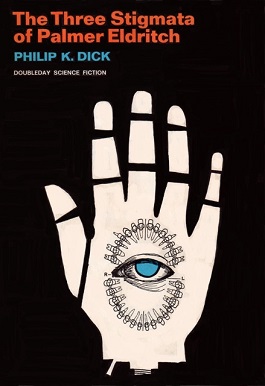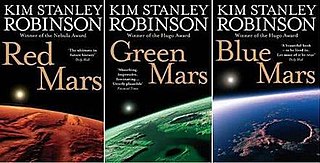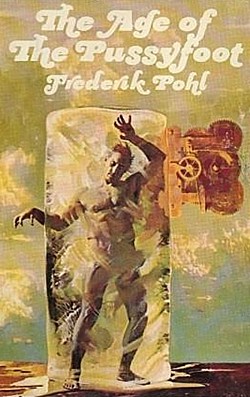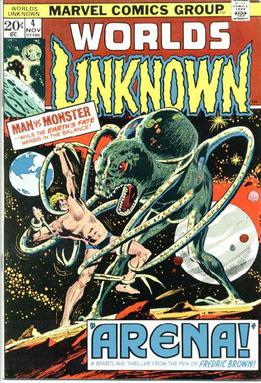
Cyril M. Kornbluth was an American science fiction author and a member of the Futurians. He used a variety of pen-names, including Cecil Corwin, S. D. Gottesman, Edward J. Bellin, Kenneth Falconer, Walter C. Davies, Simon Eisner, Jordan Park, Arthur Cooke, Paul Dennis Lavond, and Scott Mariner.

Mars, the fourth planet from the Sun, has appeared as a setting in works of fiction since at least the mid-1600s. Trends in the planet's portrayal have largely been influenced by advances in planetary science. It became the most popular celestial object in fiction in the late 1800s when it became clear that there was no life on the Moon. The predominant genre depicting Mars at the time was utopian fiction. Around the same time, the mistaken belief that there are canals on Mars emerged and made its way into fiction, popularized by Percival Lowell's speculations of an ancient civilization having constructed them. The War of the Worlds, H. G. Wells' story of an alien invasion of Earth by sinister Martians, was published in 1897 and went on to have a large influence on the science fiction genre.

The Three Stigmata of Palmer Eldritch is a 1964 science fiction novel by American writer Philip K. Dick. It was nominated for the Nebula Award for Best Novel in 1965. Like many of Dick's novels, it utilizes an array of science fiction concepts and explores the ambiguous slippage between reality and unreality. It is one of Dick's first works to explore religious themes.

Red Planet is a 1949 science fiction novel by Robert A. Heinlein about students at boarding school on the planet Mars. It represents the first appearance of Heinlein's idealized Martian elder race. The version published in 1949 featured a number of changes forced on Heinlein by Scribner's, since it was published as part of the Heinlein juveniles. After Heinlein's death, the book was reissued by Del Rey Books as the author originally intended.

The Mars trilogy is a series of science fiction novels by Kim Stanley Robinson that chronicles the settlement and terraforming of the planet Mars through the personal and detailed viewpoints of a wide variety of characters spanning almost two centuries. Ultimately more utopian than dystopian, the story focuses on egalitarian, sociological, and scientific advances made on Mars, while Earth suffers from overpopulation and ecological disaster.

John Stewart Williamson, who wrote as Jack Williamson, was an American science fiction writer, often called the "Dean of Science Fiction". He is also credited with one of the first uses of the term genetic engineering. Early in his career he sometimes used the pseudonyms Will Stewart and Nils O. Sonderlund.

Moving Mars is a science fiction novel written by Greg Bear. Published in 1993, it won the 1994 Nebula Award for Best Novel, and was also nominated for the 1994 Hugo, Locus, and John W. Campbell Memorial Awards, each in the same category. The main focus of Moving Mars is the coming of age and development of Casseia Majumdar, the narrator, as political tensions over revolutionary scientific discoveries build between Earth and Martian factions, and Mars tries to unify itself.

The Sands of Mars is a science fiction novel by English writer Arthur C. Clarke. While he was already popular as a short story writer and as a magazine contributor, The Sands of Mars was also a prelude to Clarke's becoming one of the world's foremost writers of science fiction novels. The story was published in 1951, before humans had achieved space flight. It is set principally on the planet Mars, which has been settled by humans and is used essentially as a research establishment. The story setting is that Mars has been surveyed but not fully explored on the ground. The Sands of Mars was Clarke's first published novel.

The planet Venus has been used as a setting in fiction since before the 19th century. Its impenetrable cloud cover gave science fiction writers free rein to speculate on conditions at its surface; the planet was often depicted as warmer than Earth but still habitable by humans. Depictions of Venus as a lush, verdant paradise, an oceanic planet, or fetid swampland, often inhabited by dinosaur-like beasts or other monsters, became common in early pulp science fiction, particularly between the 1930s and 1950s. Some other stories portrayed it as a desert, or invented more exotic settings. The absence of a common vision resulted in Venus not developing a coherent fictional mythology, in contrast to the image of Mars in fiction.

Colonization or settlement of Mars is the theoretical human migration and long-term human establishment of Mars. The prospect has garnered interest from public space agencies and private corporations and has been extensively explored in science fiction writing, film, and art.

Man Plus is a 1976 science fiction novel by American writer Frederik Pohl. It won the Nebula Award for Best Novel in 1976, was nominated for the Hugo and Campbell Awards, and placed third in the annual Locus Poll in 1977. The story is about a cyborg, Roger Torraway, who is designed to operate in the harsh Martian environment so that humans can colonize Mars.

The Age of the Pussyfoot is a science fiction novel by American writer Frederik Pohl, first published as a serial in Galaxy Science Fiction in three parts, starting in October 1965. It was later published as a standalone novel in 1969.

The Space Machine, subtitled A Scientific Romance, is a science fiction novel written by English writer Christopher Priest.
Pantropy is a hypothetical process of space habitation or space colonization in which, rather than terraforming other planets or building space habitats suitable for human habitation, humans are modified to be able to thrive in the existing environment. The term was coined by science fiction author James Blish, who wrote a series of short stories based on the idea.

The Last Theorem is a 2008 science fiction novel by Arthur C. Clarke and Frederik Pohl. It was first published in the United Kingdom by HarperVoyager in July 2008, and in the United States by Del Rey Books in August 2008. The book is about a young Sri Lankan mathematician who finds a short proof of Fermat's Last Theorem, while an alien invasion of Earth is in progress.

Worlds Unknown was a science-fiction comic book published by American company Marvel Comics in the 1970s, which adapted classic short stories of that genre, including works by Frederik Pohl, Harry Bates, and Theodore Sturgeon.

In the Courts of the Crimson Kings is a 2008 alternate history science fiction novel by American writer S. M. Stirling.

The War of the Worlds is a science fiction novel by English author H. G. Wells, written between 1895 and 1897, first serialised in 1897 by Pearson's Magazine in the UK and by Cosmopolitan magazine in the US. The novel's first appearance in hardcover was in 1898 from publisher William Heinemann of London. It is one of the earliest stories to detail a conflict between humankind and an extraterrestrial race. The novel is the first-person narrative of both an unnamed protagonist in Surrey and of his younger brother in London as southern England is invaded by Martians. The novel is one of the most commented-on works in the science fiction canon.
This is an incomplete list of works by American space opera and science fiction author Frederik Pohl, including co-authored works.

















